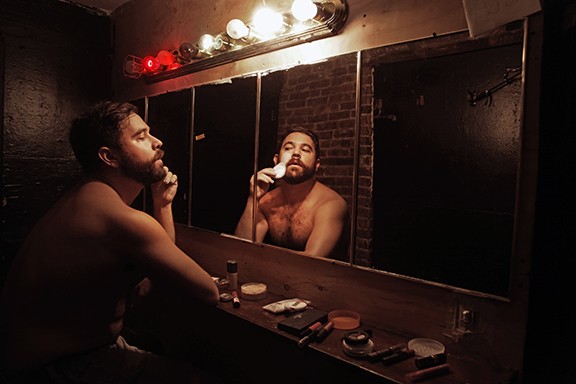You'll find such poets at the Center for Creative Photography, where 70 provocative images of 70 contemporary poets, from Pulitzer Prize winners to Instagram scribes, are filling the galleries. The poems that inspired the unconventional images hang on the walls next to the photos, by photographer B.A. Sise.
Poet Aimee Nezhukumatathil is pictured in a brilliant blue ball gown, cheerfully sitting on a rough wooden floor. Behind her is a writing table and a portrait of Walt Whitman propped up against a wall.
Her accompaning poem defies the conventions of writing, as Whitman's once did. She didn't actually write the words of her "found" poem: it consists entirely of fragments of emails written by high school students.
The poem got its start after teens in an unnamed school were assigned to read Lucky Fish, her book of poems, alongside Whitman's masterwork Leaves of Grass.
Then they wrote the author to tell her exactly what they thought.
When Nezhukumatathil read their provocative comments, she spliced the kids' cascade of critiques and shaped them into a poetic narrative.
"I think I like Walt Whitman better than you," one student writes in the poem, "but don't take offense—you are very good too!"
Another student insists on the opposite: "Thank you we have taken a debate and you are a far better poet than Walt Whitman."
One teen applauds Aimee for writing works that are easy to read: "...for a fast hour and a half read, your book takes the cake." Still another trails away from poetry altogether and asks for advice on how to deal with "creepy mean guys...What would you do?"
In the final line, an honest soul goes back to the main point, crisply stating, "Walt Whitman is better than you."
A wonderful collage of teen talk, at once brutal and charming, Nezhukumatathil's rollicking free verse makes poetry out of life itself. Ironically, it would not even have been called poetry back in the days before her putative rival Whitman blew up the rules for writing. But the piece fits right in with Whitman's poetry revolution.
During his 72 years on earth, from 1819 to 1892, Whitman challenged the old rules of poetry, championing work that neither rhymed nor conformed to meter. And he widely broadened the topics that poets could write about.
"He created a possibility that didn't exist before," says Tyler Meier, executive director of the UA Poetry Center, which is co-sponsoring the exhibition with the Center for Creative Photography. "The wild and exciting poetry of today" owes a lot to this legacy.
The exhibition, A Portrait of Poetry, celebrates the 200th birthday of Whitman while honoring today's free-wheeling poets. Photographer Van Sise's selection of poets, Meier adds, is "an authentic portrait of the landscape of poetry at this moment. It's a giant cross-section."
Van Sise, a distant descendent of Whitman, has loved poetry ever since his own high school years, when he says he would sneak into class early and scribble chalk verse on the blackboard. As the 200th birthday drew near, it occurred to him to do a photo project that would not only pay tribute to his famous ancestor but would lionize Whitman's literary descendants.
Seeking out recommendations from every poet he met on who else he should photograph, he successfully reeled in poetry names big and small. He picked the poems he wanted to highlight, but his literary subjects gave their two cents and more on what the photos would look like.
Up-and-comer Sam Sax, born in 1986, is one of the youngest, and his poem is as challenging as his portrait; it evokes sex performances in sleazy surroundings. One line reads, "what is a poem worth, anyway?/ten dollars at the door? the long stair/ case? the soiled cloth seats?" Sax dresses as a performer for his photo. He's in a dive theater putting on makeup backstage, and his flesh glows in the colored mirror lights.
Erika Sánchez, another of the younger poets, wrote the wrenching "Six Months after Contemplating Suicide," about coming close to the brink of death, and then receding: "...instead of swallowing a fistful/of white pills,/you decided to shower...The ghost? It fell prostrate,/passed through you/like a swift and generous storm."
Her Van Sise photo catches her in a cemetery at twilight. She walks between the grave stones with a fiery torch in her hand and a small smile of triumph on her face.
There are plenty of giants in the show. Joy Harjo, the first Native American poet laureate of the U.S., is sitting with a horse in an equine-friendly café. But the poem, "Drowning Horses," is darker than the photo. A woman tells the narrator by phone that she might kill herself. The horse dissolves into metaphor: "Her escape is my own./I tell her, yes. Yes. We ride/out for breath over the distance./Night air approaches, the galloping/other-life."
The revered Robert Hass is the poet running away across a New York street with a bicycle on his shoulder in his photo; the image comes from a complex and loving poem about his wife. More than anything else, he says, she wants a yellow bicycle.
A giant of American poetry, Rita Dove, an African American who once served as poet laureate of the U.S., is pictured in twilight, in front of Monticello, crouching in the grass and lighting candles where Thomas Jefferson's slaves once labored. Jefferson built Monticello, his home, and also created the nearby University of Virginia, where Dove teaches and where a violent right-wing riot erupted two years ago.
The photo is paired with Dove's poem "Demeter's Prayer to Hades," written in 1994, long before the Nazis swarmed Charlottesville—and before gunmen staged massacres in El Paso and Dayton. But the words of the poet still speak to the moment.
"This alone is what I wish for you: knowledge...to know we are responsible for the lives we change." ■













